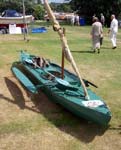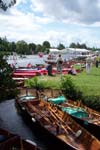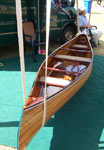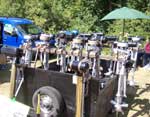Thames Traditional Boat Rally
by Chris
Partridge
Henley-on-Thames is best known for its Royal
Regatta, an event where some of the world's top athletes hammer
down the river on kevlar toothpicks.
Then, a week later, a bunch of non-athletes
arrive and swan elegantly about, gently sculling in beautiful
mahogany skiffs, idly adjusting the controls of a steamboat
or simply sitting in the cockpit of a gentleman's motor launch,
drinking champagne. That is the Thames Traditional Boat Rally
for you.
I know which event I prefer, though the Rally
can get depressing for a backyard boatbuilder.
To qualify as 'traditional', plastic and plywood
are banned, except for minor details. All the boats are solid
wood or riveted steel. Everywhere, it is gleaming mahogany,
brass and chrome. The sanding! The polishing! The money, oh
Lord the money!
It is a world away from the plywood and plastic
world of the average amateur boatbuilder. But I got a lot of
ideas and encouragement from the event, quite apart from the
sheer enjoyment of seeing these wonderful boats, many old but
some new, demonstrating that old-time craftsmanship is alive
and kicking.
And, this being England, there was an awful
lot of dressing up in striped blazers and straw boaters. One
chap even had a red left sock and a green right sock, so if
he forgets which is port and which is starboard, he can just
hoick up his turnups and take a look…
The show was a good excuse to visit the new
Henley River and Rowing Museum, which contains Olympic eights,
several early racing boats and an interesting history of the
sliding seat from its invention in the USA in 1851. Originally,
racers used to sit on greased mats to move to and fro, so putting
the seat on wheels must have been a revelation.
Here are some of the
highlights of the rally:
(click pictures to enlarge)
 |
One of the most interesting boats was a
wartime canoe used by Britain’s Special Boat Squadron,
the Marines’ version of the SAS. It has outriggers
each side designed to be quickly detached and reattached,
so when the sub surfaced to drop the soldiers on an enemy
coast, the boat could be hauled through the torpedo tubes
in bits and assembled on deck. A simple lateen sail provides
wind power. The boat is now kept in the Classic Boat Museum
on the Isle of Wight. |

| A whole fleet of Thames rowing skiffs were
at the rally, mainly built in mahogany. Many are over a
hundred years old and still on the water. |
 |

 |
An example to all home boatbuilders –
Philip Corfield built Hi Jeeves, a lovely speedboat in the
1930s style. Here, he revs up to show off before the judges,
followed by a couple of launches dating from before the
First World War. Moored round the posts behind is a flotilla
of Thames sculling boats that have somehow moved to Amsterdam,
revisiting their home waters under the Dutch flag. |

| A couple of skiffs, one English and one
Dutch, sail past looking as though the slightest gust could
knock them over. The crews look calm to the point of asleep
though. |
 |

 |
A sculler puts his back into it as a 1930s
cabin cruiser passes behind. |

| Just what you can do with strip planking
with hard work and unbelievable craftsmanship. |
 |

 |
This nice stitch and glue canoe sneaked
in despite the ban on plywood. Here she nestles under a
charming mermaid figurehead on the bow of an old cabin cruiser. |

| A group of ‘slipper launches’,
though their elegantly sloping rear ends are hidden in this
picture. |
 |

 |
The tradition lives - a new skiff built
in traditional style by boatbuilder Peter Freebody. |

| A flock of Seagulls roosting on a trailer.
The Seagull was a noisy, smelly, inefficient but totally
indestructible British-made outboard now regarded with deep
nostalgia over here. |
 |

 |
A mahogany double skiff with oars pivoted
on thole pins rather than rowlocks. |
 |

 |
Someone has a lot of work on their hands
with this nice but battered Canadian canoe. |
More on the Thames Traditional Boat rally
is on www.tradboatrally.com.

